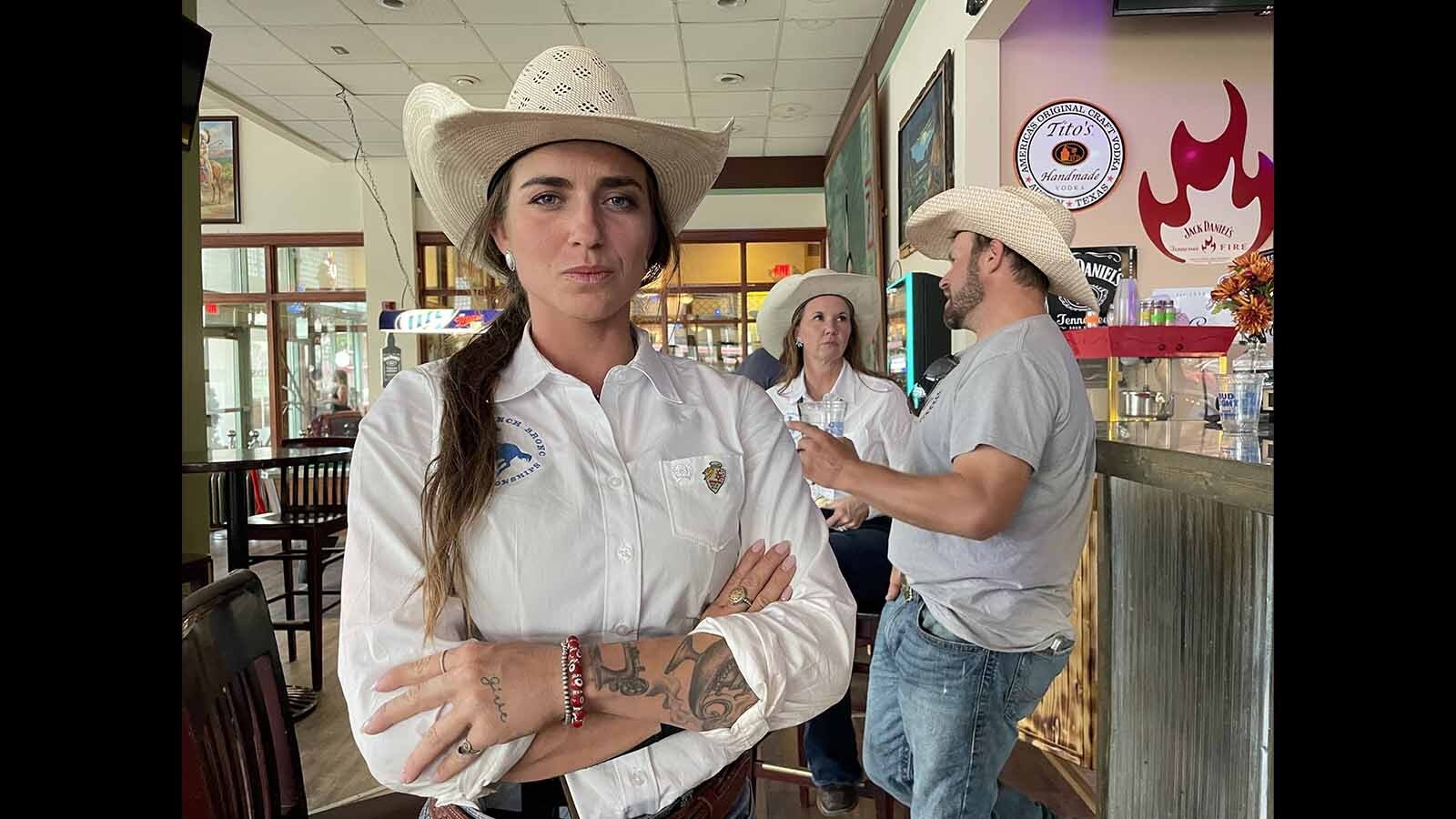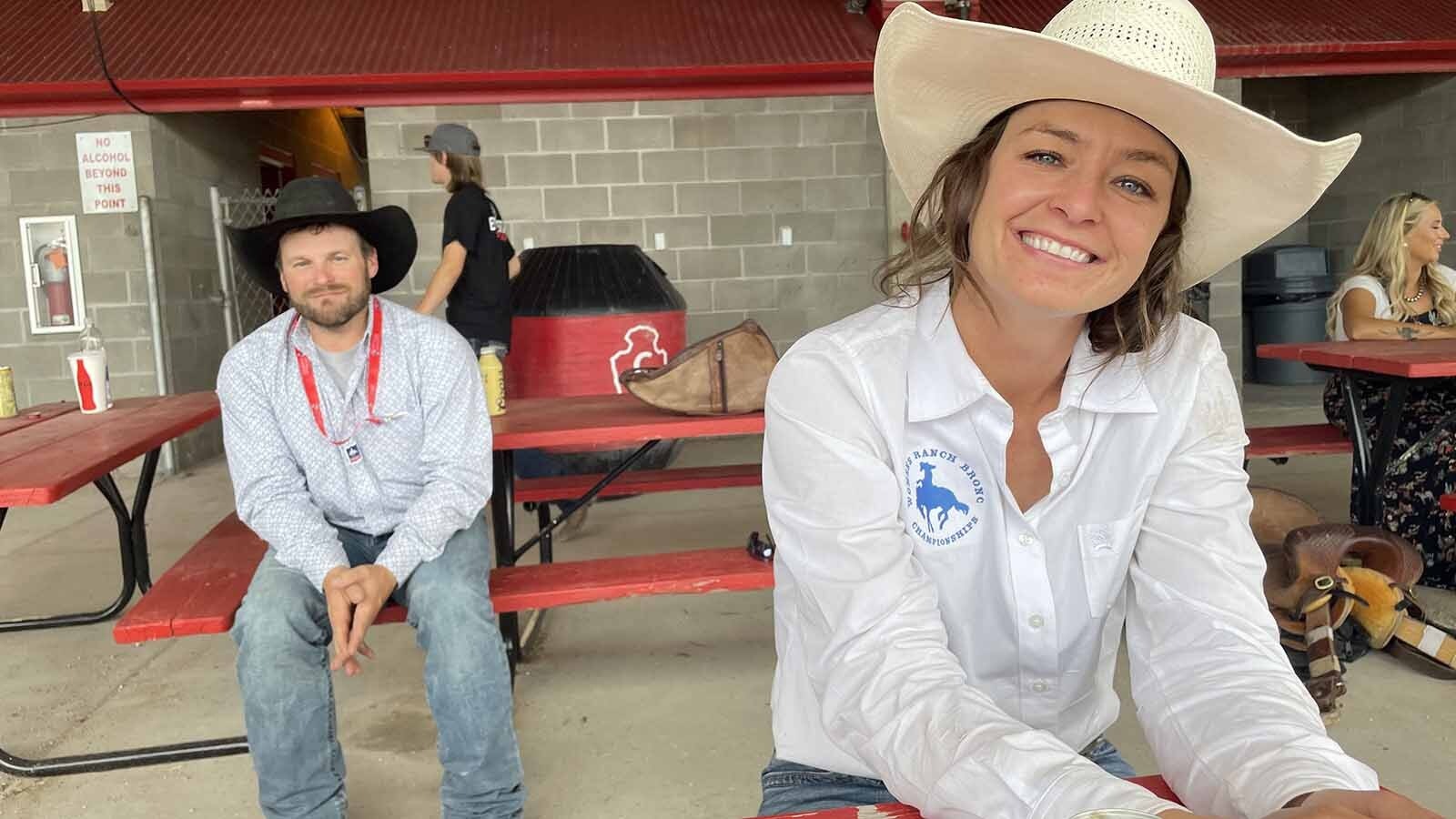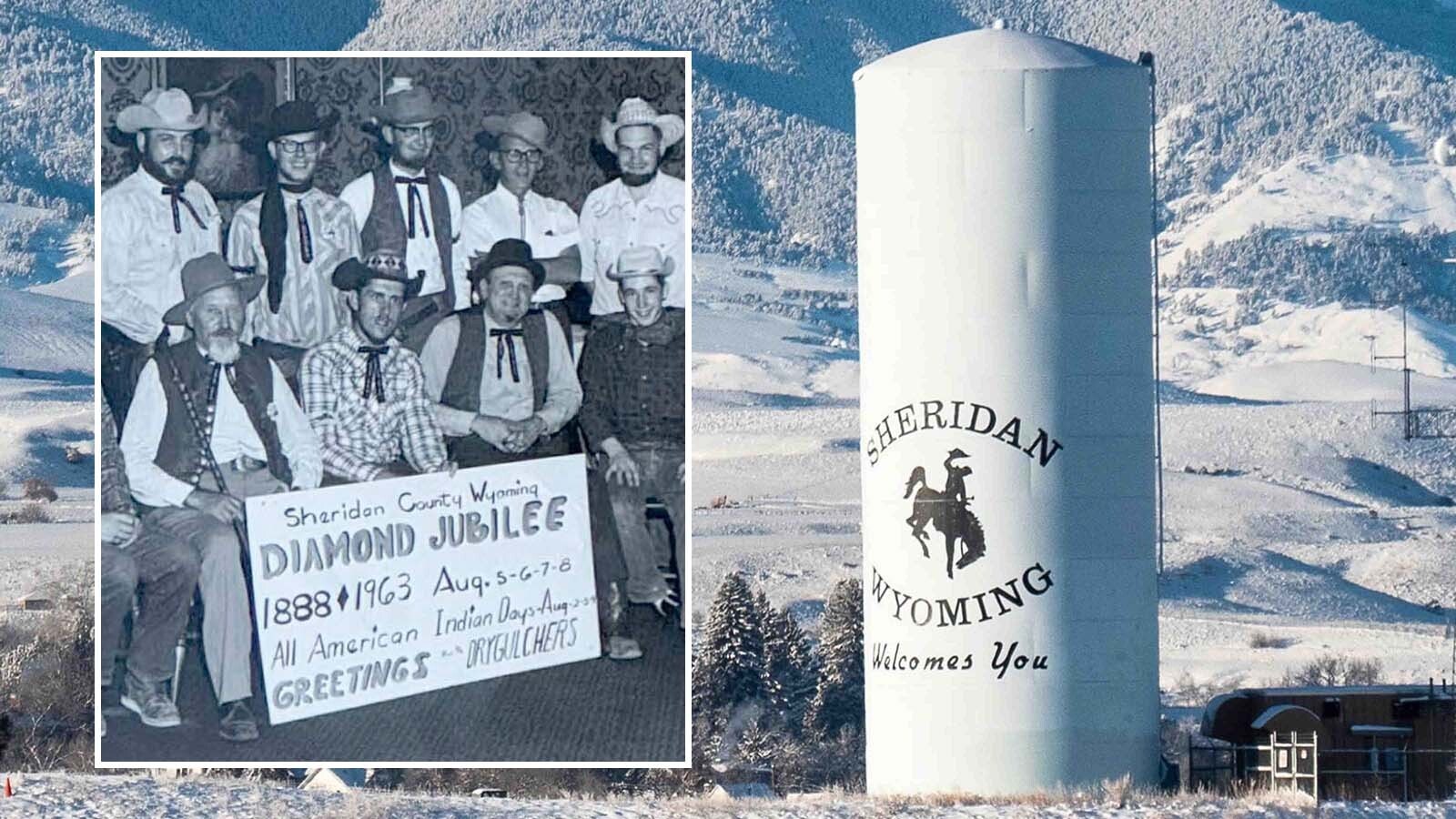CHEYENNE — Women ranch bronc riders are athletes of a different color.
Take Tup Forge, a 28-year-old Australian who just won the world gold buckle in the Cheyenne Frontier Days Rodeo Women’s Ranch Bronc Championship — on three hours of sleep.
“I'm still on Australia time, and I’m still well-and-truly jet lagged. I didn’t get to sleep until 4 o'clock this morning,” she said.
Nevertheless, considering the big afternoon ahead, wouldn’t she allow herself to rest up and sleep in at least a little bit?
“Not me. I’ve got to get up early and get about my day. Get up and get at it and get it done,” she said, with a deep Aussie accent and even deeper sense of purpose.
Forge is sitting on a high stool in a green gingham shirt in the lobby bar at Historic Plains Hotel in Cheyenne, where the Women’s Bronc Riding Championship (WRBC) affiliates have come to celebrate their season culmination at Cheyenne Frontier Days.
There’s a glint of dazed excitement in her eye as she reflects on her win, giving the impression she’s looking through you rather than at you, as though she’d just been rousted from an incredible dream.
No wonder, given her current reality feels a lot like a dream.
“I honestly couldn’t believe I won. There were tears. I was shaking. I could barely even hold my buckle,” she said, caressing her side braid, long and auburn like a tapered fox tail.
Her win comes at a moment of heightened popularity for women’s rough stock and marks the ninth year since female bronc and bull riders were allowed back into the rodeo establishment after an 87-year moratorium.
The exclusion of female bronc riders was a prolonged reaction to the death of a Boise cowgirl named Bonnie McCarroll at the Pendleton Round-Up in 1929.

Definitely Not For The Money
This go-round, the rules have changed. In contrast to the hornless saddles used by men, women ride slightly modified ranch saddles.
“We ride what we rope in,” said one WRBC member.
But even as the sport is gaining notoriety, the rodeo circuit is far from lucrative for the women of WRBC.
Quite a few of these girls will even lose money after the cost of travel, equipment and event fees. That’s why in this sport, even world champions can second-guess their priorities.
“I feel really bad because my parents are still working so hard on the ranch back home, and I’m just out here enjoying myself,” Forge said.
Forge grew up in the saddle on a cattle ranch in Victoria, Australia. She began riding broncs in late 2023 and has been a weekend warrior in the Australian circuit ever since.
Her routine is to leave home on a Friday evening and drive across the country to make a rodeo the following night. She’d be on the road first thing the day after and back in time to saddle up by first light Monday.
For Forge, this is what it means to take time off, a notion that feels somewhat upside down, like the night sky in the southern hemisphere.
“I try not to take too many days off, and we work weekends at home, so I really feel like I was wagging,” she said with a chuckle.
It’s a major illustration of the cultural difference between real cowgirls like Forge and what you might call a regular person like this reporter here, who is more than happy to take weekends off, and if anything, a bit indignant that they’re only two days long.
“I don’ t see rodeo as a career. My life back home is too busy, so I don’t think I’m going to continue going so hard with the rodeo,” she said.
American bronc riders, too, struggle with the tradeoffs of rodeo life. Although in some ways, that’s precisely what makes this sport so special: The passion of its athletes is fierce and unadulterated, according to Michelle McElroy, international director of the WRBC.
“That's the thing with rodeo that a lot of people don't understand. There's no guaranteed paycheck, so you have to really, really love it,” said McElroy.
Rodeo Is A Lifestyle
Halee Staskivige really, really loves it.
“I relate it to a surfer finding a perfect wave. When you get on that horse and you're with it, it doesn’t feel rough. When you're in sync with the bucking horse, it feels awesome, it’s addictive,” said Staskivige, sipping a beer beneath the stadium after her final ride in Cheyenne.
With silky brown hair, blue eyes and a flawless smile that deserves its own sparkle-chime sound effect, Staskivige exudes surfer-girl vibes. But this cowgirl is actually from the heartland.
She grew up around horses on a farm in Northwood, North Dakota, the sort of small rural town where girls like her finish high school with a graduating class of nine.
She went to college in Minnesota on a volleyball scholarship, and beelined for the West with a marketing degree four years later.
She bounced between office jobs in Bozeman, Montana, while feeding her passion for horses with a growing list of side-gigs, including seasonal work on dude ranches, trail riding outfits, and trainer shadowing.
“I always knew I wanted to work in the Western industry. It just took me a while to figure out how,” she said.
The catalyst came at the start 2023, when she enrolled in a bronc riding seminar and discovered a runaway talent with bucking horses.
“That was when I decided, ‘OK, I’m going to do this. I’m going to give the rodeo life a shot,’” she said.
She emptied her savings to buy a fifth-wheel trailer, subleased her apartment and hit the road.
She’s now on the circuit full time. It’s come with unanticipated challenges both big and small, like adjusting to 10-hour-days behind the wheel. But she found an instant support system in the rodeo community.
“It sounds corny, but it does start to become a family. The girls all help each other, everyone looks after each other, because they all know it can be hard,” she said.
This may be a unique American phenomenon, according to Forge, who explained she was pleasantly surprised by the care and support the American riders show each other.
“The girls in America are so helpful. It’s beautiful. They want you to do well and they couldn’t have been more happy for me. In Australia, it’s not quite like that,” Forge said, taking time to note other differences that stick out.
“Everything is so big here. Your cars are huge. Your meals are huge. Your buildings are massive. Your roads are massive and wide. Even your bucking horses are bigger. I had to buy a new cinch when I got here.”
For Staskivige, the rodeo family dynamic goes even deeper, because she fell in love with a clown.

In Love With A Rodeo Clown
Willie Wilson was raised in a logging town of Molalla, Oregon, and joined the professional circuit as a bare back rider before transitioning to a bullfighter and eventually a rodeo clown.
He didn’t just flirt with the danger of bulls.
“Here was this rodeo clown who was kind of spicy. He’d say stuff like, ‘Come on now are you ready yet?' or ‘How’d you get all that mud on you?’ or ‘What’s your name again?’” said Staskivige, describing her interactions with Wilson at a weekly summer rodeo in Big Sky, Montana.
“At first, I thought he was just rude, but I started to put it together and said, wait, is this rodeo clown flirting with me right now.”
Wilson, with a week's worth of facial scruff and a sheepish smile, attributes their chemistry to clown cosmetics.
“It was the makeup that got her attracted to me,” he said.
He sealed the deal on a shivering-cold New Years Eve at the 2024 North Dakota Winter Show rodeo, which Staskivige will never forget.
“There’s something magical about an arena when no one's there,” she said. “The trick horses and bucking horses are eating their dinner and relaxing. It smells like hay, and it smells like arena dirt. We walk behind the bucking chutes, and he gets down on one knee.”
The news broke instantly, and the rodeo family swarmed them in celebration.
“They were jumping up and down,” she said. “To have your favorite people there for that and everyone’s extremely happy for you? So great!”
Although with independent careers, they spend just as much time apart. After Cheyenne, he’ll load his 40-foot trailer and head west to Utah, and she’ll head north for the Days of ’76 Rodeo in Deadwood, South Dakota.
Time away from loved ones is but one of the challenges of this lifestyle, which requires strength in spirit, mind and — lord knows — body too.
There are slight differences between men’s and women’s rough stock events regarding format and rules. When it comes to physical brutalization, gender parity is guaranteed.
Between the bull and bronc riders in Cheyenne, women were falling out of the sky like raindrops.
‘Quit Your Bitching’
Ally Bradley is an English show horse trainer from Texas who found her way into rough stock after a bad heart break. Bulls and broncs, she learned, are the ultimate coping mechanism.
“I went through a nasty break up and just sensed I should start getting on bulls. It changed my life for the better in ways I wasn’t expecting, in all aspects,” she said, explaining that she would later transition to broncs exclusively, which helped her reconnect to a sense of inner worth.
It almost goes without saying, but why pass on an easy metaphor.
“Like life, you get bucked off, are you gonna get back on? I didn’t realize until the breakup, but I’d lost myself. I forgot I was a badass,” she said.
If tolerance for pain is what makes a badass, then yes, Bradley is a bonafide badass.
Sitting in the lobby bar at the Historic Plains Hotel, Bradley’s knuckles are bruised and cut, her wrist and arm are taped, and her white Western shirt is smeared with arena dirt from one of her tumbles in Cheyenne.
More surprising is that she was able to compete at all in CFD, given the beating she took in Steamboat Springs, Colorado, two weeks earlier, when a real bucker dropped her in the dirt with a laundry list of injuries.
“Both of my groins were black, maybe pulled, my butt was seriously bruised,” Bradley said. “My hand had a strange bump on it and it hurt to lay my hands on anything. It was hard to put myself back together and get to Cheyenne."
And what did the doctor recommend?
“If you go to the doctor, they’re going to tell you to stop doing what you're doing. I don’t want to hear that. I want my belt buckle,” she said.
One piece of Bradley’s success, and what may yet become her demise, is a unique mindset toward pain. For her, bodily damage is not a matter of if or when so much as how.
“People get after me and say what are you going to feel like when you're older?” she said. “But I know people who are older who have done less with their bodies, and they are getting shoulder replacements and knee replacements from living a basic suburban life.
“If they’re getting a knee replacement, then I sure as hell am, and I’m going to earn it. Either way your body deteriorates. I want to use the thing. It would suck to go your whole life and not live in your body. That’s what really scares me. If you can’t take it out of your mind for 8 seconds, you shouldn’t be doing this,” she added, paraphrasing two-time world championship bull rider J.B. Mauney.
Sounds catchy, but what about the other 23 hours, 59 minutes and 52 seconds of the day?
“Just put a Band-Aid on it and quit your bitching.”

Emotional Pain
Much more than bruised ribs and bloodied knuckles, the deepest pain is the emotional let down that comes when a rider fails to meet their own expectations.
It’s a feeling that hangs over Staskivige as she takes her leave of Cheyenne. Her heart and mind have been focused on success at CFD since she first started riding bronc.
You’d have a tough time telling because she’s an inherently happy person, but under the surface she’s kicking herself, according to Wilson, her fiancé.
“She’s not showing it, but I can tell she’s hurting. I know because I’ve been there too. It’s a hard disappointment when you get bucked or can’t cover,” Wilson said privately.
But defeat in Cheyenne is not an ending, it’s another beginning. For Staskivige, rodeo is about more than buckles. Rodeo is lifestyle.
“Sometimes you’ve got to put everything else on the backburner to make it work and other things in life can fall apart,” she said. “I see it with other girls too. You're not home to take care of your horses and you're away all the time and everything else. But I see rodeo as a lifestyle, and I do it because I really love it.”
What About Tup?
As for Forge, it remains to be seen what will come of her rodeo career.
But she says that CFD was meant to be, because her friend was looking down on her from the heavens.
Forge is an athlete of sentimental superstition. In every bronc event, she wears the same pair of lucky socks gifted by her 93-year-old grandmother.
She also wears a lucky scrunchie that belonged to her best friend, Ames Pilgrim.
Pilgrim and Forge grew up together. They worked and lived together. They were inseparable best mates, until a tragic night in 2020 when Pilgrim died in a motor vehicle accident en route to a cattle station where she was set to reconnect with Forge.
“I carry her photo in my vest, and I wear her scrunchie every time I ride,” Forge said, stretching out the green scrunchie on her wrist. “And I just knew it when we rolled into this town and saw that we’re staying on the corner of Ames [Court]. I thought, ‘You're kidding.’ I knew it was meant to be. I just knew Ames was looking down on me in the arena.”
She feels guilty for leaving her folks understaffed on the family ranch back home, but they’ll have to get by a while longer because her American itinerary isn’t complete.
On her to-do list abroad: hike the Rocky Mountains, visit the Fort Worth Stockyards and, luck permitting, get a glimpse of America’s most exotic wildlife.
“I really want to see a racoon,” she said. “I’ve seen a squirrel, and that was fun, but I really want to see a raccoon.”
Zakary Sonntag can be reached at zakary@cowboystatedaily.com.





